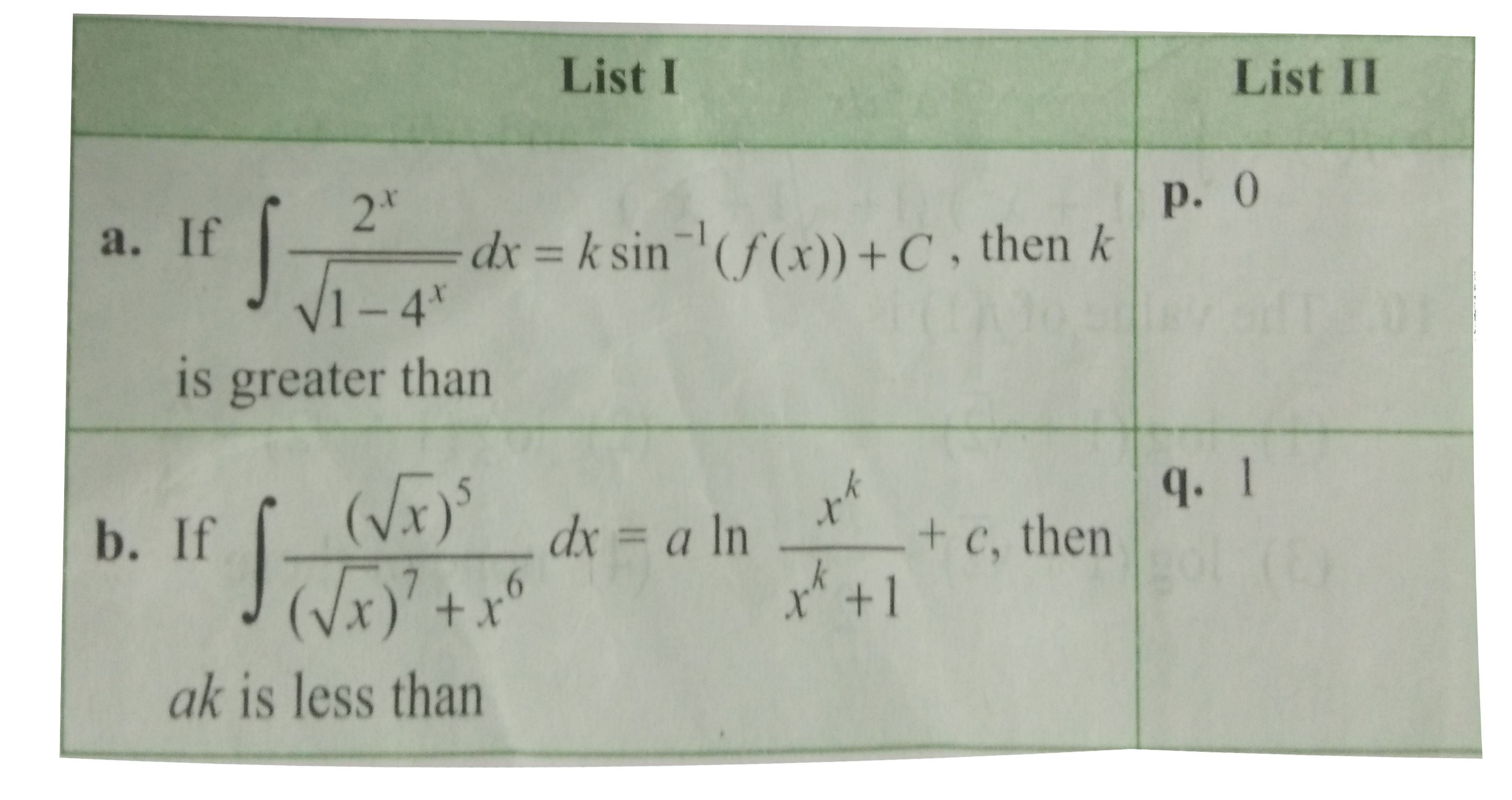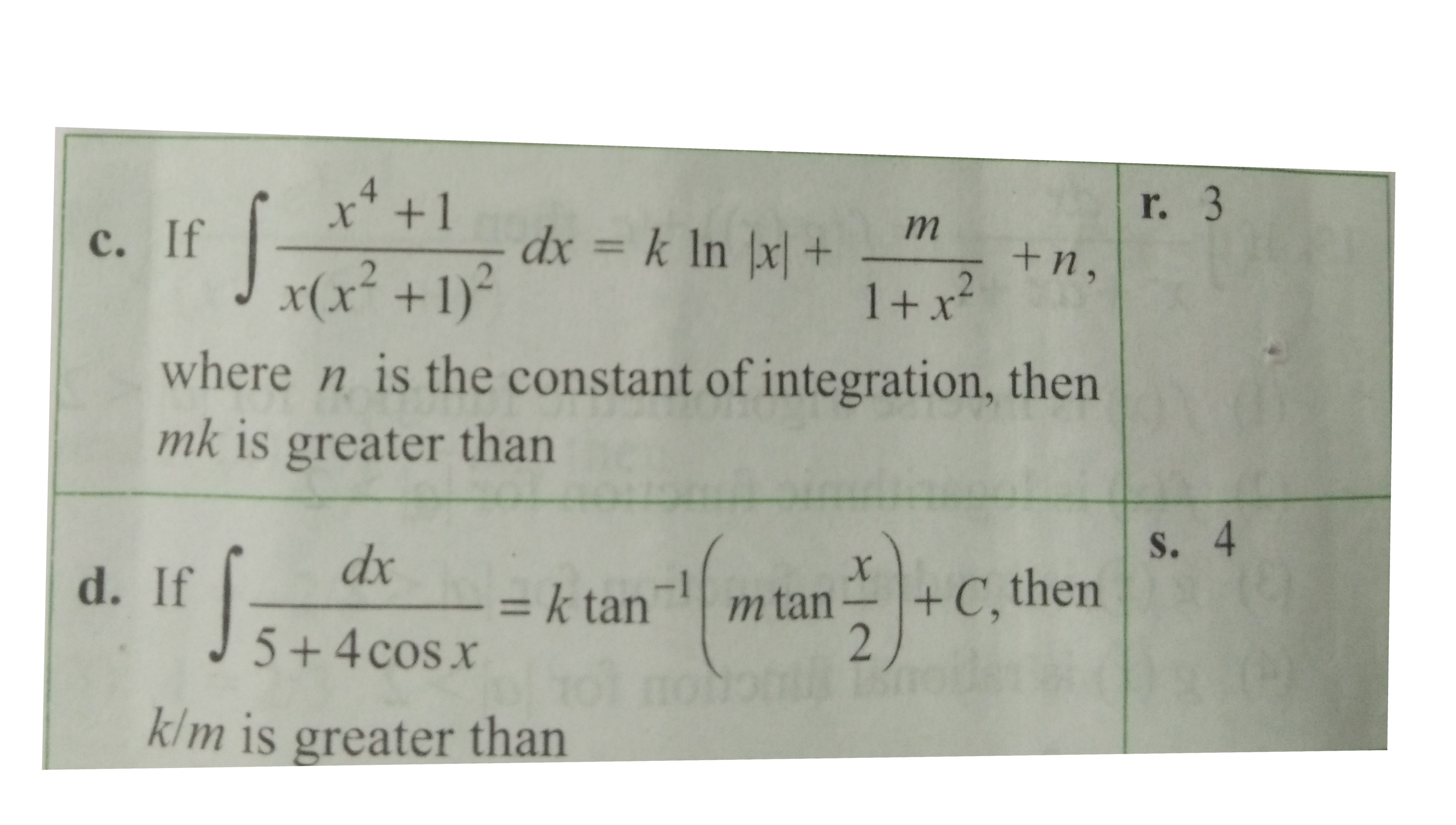If f(x)=√x,g(x)=ex−1, and ∫fog(x)dx=Afog(x)+Btan−1(fog(x))+C, then A+B is equal to Solution in Bengali
The correct Answer is:0
fog(x)=√ex−1
∴I=∫√ex−1dx
=∫2t2t2+1dt, where √ex−1=t
=2t−2tan−1t+C
=2√ex−1−2tan−1(√ex−1)+C
=2fog(x)−2tan−1(fog(x))+C
∴A+B=2+(−2)=0
Topper's Solved these Questions
- BOOK - CENGAGE PUBLICATIONCHAPTER - INDEFINITE INTEGRATIONEXERCISE - Archives JEE MAIN (Single Correct Answer Type)7videos
INDEFINITE INTEGRATION
- BOOK - CENGAGE PUBLICATIONCHAPTER - INDEFINITE INTEGRATIONEXERCISE - Archives JEE ADVANCED (Single Correct Answer Type)1videos
INDEFINITE INTEGRATION
- BOOK - CENGAGE PUBLICATIONCHAPTER - INDEFINITE INTEGRATIONEXERCISE - EXERCISES (Matrix Match Type)4videos
INDEFINITE INTEGRATION
- BOOK - CENGAGE PUBLICATIONCHAPTER - HYPERBOLAEXERCISE - COMPREHENSION TYPE2videos
HYPERBOLA
- BOOK - CENGAGE PUBLICATIONCHAPTER - INEQUALITIES AND MODULUSEXERCISE - Single correct Answer21videos
INEQUALITIES AND MODULUS
Similar Questions
If the integral ∫5tanxtanx−2dx=x+aIn|sinx−2cosx|+k, then a is equal to
03:11View SolutionThe integral ∫sec2x(secx+tanx)92dx equals (for some arbitrary constant K). (a)−1(secx+tanx)112{111−17(secx+tanx)2}+K (b)1(secx+tanx)111{111−17(secx+tanx)2}+K (c)−1(secx+tanx)112{111+17(secx+tanx)2}+K (d)1(secx+tanx)112{111+17(secx+tanx)2}+K
01:37View SolutionMatch the following lists:

 03:31View Solution
03:31View SolutionThe circle x2+y2−8x=0 and hyperbola x29−y24=1 I intersect at the points A and B. Equation of a common tangent with positive slope to the circle as well as to the hyperbola is (A) 2x−√5y−20=0 (B) 2x−√5y+4=0 (C) 3x−4y+8=0 (D) 4x−3y+4=0
03:20View SolutionIf f(x)=ax2+bx+c and f(−1)≥−4, f(1)≤0 and f(3)≥5, then the least value of a is
02:04View SolutionIf f(x)=ex and g(x)=(log)ex(x>0), find fogandgof. Is fog=gof?
05:37View SolutionIf f(x)=√x(x>0)andg(x)=x2−1 are two real functions, find fogandgof is fog=gof?
02:38View Solution(A) If f(x) is even &g(x) is odd then fog is (B) If g(x) is periodic then fog is
04:19View SolutionIf f(x)=(x^(2)+1)/(x^(2)-1) and g(x)=tan x, then discuss the continuity of fog(x)
01:59View SolutionIf f(x)=(x)/(sqrt(1-x^(2))),g(x)=(x)/(sqrt(1+x^(2))) then ( fog )(x)=
06:33View SolutionIf f(x)=√x,g(x)=ex−1, and ∫fog(x)dx=Afog(x)+Btan−1(fog(x))+C, then A+B is equal to −.
03:55View SolutionIf ∫1√2ax−x2dx=fog(x)+C , then
03:44View SolutionIf f(x)=√∣∣3x−31∣∣−2andg(x)=tan pi x, then domain of fog(x) , is
01:31View SolutionIf f(x)=x√1−x2,g(x)=x√1+x2 then (fog)(x)=
01:23View Solutionयदि f(x)=√x,g(x)=ex−1 तथा ∫fog(x)dx=Afog(x)+Btan−1[fog(x)]+C, तो A+B का मान है
04:22View SolutionIf f(x)=√x,g(x)=ex−1,and ∫fog(x)dx=Afog(x)+Btan−1(fog(x))+C, then A+B is equal to .
03:17View Solution

